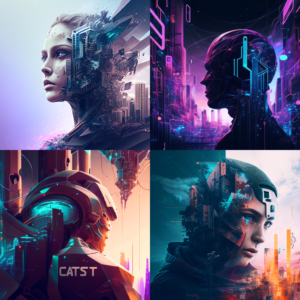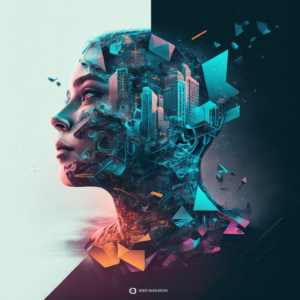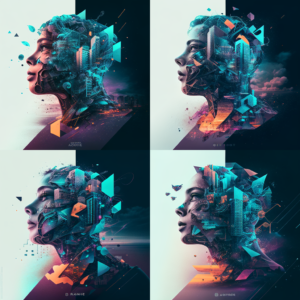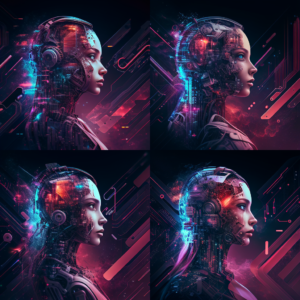Open-AI launched Chat GPT, a chatbot, in Nov 2022. It is based on Open-AI’s GPT-3 family of language models and is tuned for using monitored and reinforcement learning methods. The process of predicting the next word in a list of words is performed by large language models. Chat GPT is a divisive artificial intelligence source which can be queried for surprisingly coherent responses. It’s far from perfect, and what improved way to put it to the test than by asking it open-ended queries that end up causing living creatures to meltdown on social media? Chat GPT learns how to obey instructions and provide responses that are acceptable to humans using Reinforcement Learning and Human Feedback, an extra training layer.
Created some images through Discord channel of Midjourney.
Writing some prompts to build in some seconds some unique images as an example






Large Languages Model:
An LLM is Chat GPT. Massive volumes of data are used to train large language models to precisely anticipate what word will appear next in a phrase.
It was shown that the language models could perform more tasks when there was more data available.
Stanford University claims that:
- In GPT-2, this tendency was largely missing. Additionally, although failing at some tasks, GPT-3 beats models were specifically trained to handle those problems.
- GPT-3 was trained on 570 terabytes of text and has 0.175 trillion parameters. For comparison, GPT-2, its forerunner, had 1,500 million parameters, which was nearly 100 times smaller.
- The behaviour of the model is substantially altered by the increase in scale; the GPT-3 is now capable of carrying out tasks for which it was not specifically taught, such as translating lines from English to French, with little to no training data.
Similar to autocomplete but on a mind-boggling scale, huge language models predict the following word in a string of words in a sentence as well as the following sentences.
They are able to produce paragraphs and full pages of text thanks to this skill.
Large language models, however, have limitations because they frequently fail to grasp the precise nature of human motivations.
In addition to the aforementioned Reinforcement Learning using Human Feedback training, Chat GPT surpasses the current state of the art in this area.
Who Trained Chat GPT & how?
To assist Chat GPT to learn dialogue and develop a human manner of response, GPT-3.5 was trained on enormous volumes of code-related data and knowledge from the internet, including sources such as Reddit debates.
To teach Artificial intelligence what people anticipate when they ask a question, Reinforcement Learning using Human Feedback was also used to train Chat GPT. This method of training the LLM is novel since it goes beyond only teaching it to anticipate the next word.
This is a ground-breaking method, as detailed in a research article published in March 2022 titled Training Language Models to Follow Directions with Human Feedback:
- Language models by default focus on improving the next word prediction objective, which is merely a stand-in for what we want these models to perform.
- By teaching them to follow the instructions of a specific group of humans, we hope to boost the beneficial effects of big language models.
- Growing language models does not automatically improve their ability to interpret user intent.
- Our findings suggest that our methods have the potential to improve the value, accuracy, and safety of language models.
- LLMs, for instance, may produce results that are harmful to the user or untruthful.
- In other terms, these models do not take their users into account.
To grade the outputs of the two systems, GPT-3 and the new Instruct GPT, a similar model of Chat GPT, the developers who designed Chat GPT recruited contractors referred to as “labellers”. The ratings led the researchers to the following findings:
- Compared to GPT-3, Instruct GPT exhibits marginally fewer toxicities but no bias.
- Instruct GPT outputs are substantially preferred by labellers compared to GPT-3 outputs.
- Instruct GPT models outperform GPT-3 in terms of veracity.
The research article concludes that the outcomes for Instruct GPT were successful. Even so, it acknowledged that there remained development opportunities.
“Overall, our findings show that big language models can be greatly improved by leveraging human preferences to fine-tune them, while considerable work needs to be done to increase their safety and dependability.”
Chat GPT was specially taught to comprehend the human intent behind a query and offer useful, honest, and harmless answers. This distinguishes Chat GPT from a straightforward chatbot.
As a result of that instruction, Chat GPT may challenge particular questions and ignore any unclear portions of the inquiry.
Another study on Chat GPT demonstrates how they programmed Artificial intelligence to anticipate human preferences.
The researchers discovered that the metrics used to evaluate the outputs of natural language processing Artificial intelligence produced machines that performed well on the metrics but didn’t match what people would have anticipated.
The researchers provided the following explanation of the issue:
“Many machine learning applications focus on maximizing straightforward measures that are only approximate proxies for the designer’s intentions. This may cause issues, such as YouTube suggestions that promote clickbait.
The idea they came up with was to develop an Artificial intelligence that can produce replies that were tailored to human preferences.
To achieve this, they trained the Artificial intelligence utilizing datasets of human evaluations of various replies to improve the machine’s prediction of what humans would deem to be satisfactory answers.
Next Time we dig deeper in
How do we begin using ChatGPT?


